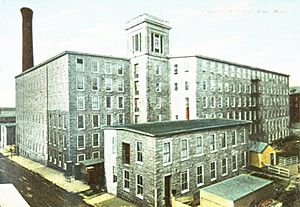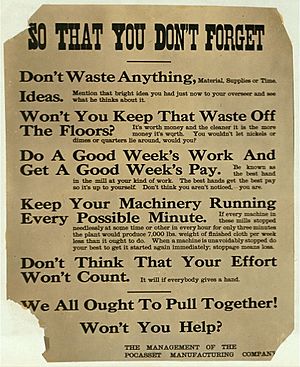Pocasset Manufacturing Company facts for kids
The Pocasset Manufacturing Company was a large factory in Fall River, Massachusetts. It made cotton cloth, also known as textiles. The factory was built in 1822 near the Quequechan River. Sadly, the Pocasset Mills were destroyed in the Great Fall River Fire of 1928. This fire also ruined a big part of the city's business area.
Contents
History of the Mills
In its early days, the Pocasset Company built factories for other businesses to use. One of their first projects was to make a grist mill (a mill for grinding grain) bigger. But then, a man named Oliver Chace decided to tear down the grist mill. In its place, they built a new factory to make textiles. An older fulling mill (used for cleaning and thickening cloth) stayed in place.
The Bridge Mill
The new textile factory was called the "Bridge Mill." It was made of stone and had three floors. It was about 100 feet long and 40 feet wide. This mill was located west of Main Street, right next to the Fall River stream.
In 1821, a machinery company called Harris, Hawes & Company used two floors of a building built by Pocasset. The basement of this building was still used as a grist mill. They even built a water-wheel to help raise water for laundry. Both the "Bridge Mill" and the fulling mill were destroyed in the Great Fire of 1843. After this fire, the company built the original Granite Block. This building became a very important business center in Fall River for many years.
The Satinet Mill
In 1825, the stone Satinet Mill was built. Part of this mill was used by the first calico printing business in Fall River, started by Andrew Robeson. Calico printing is a way to print colorful designs on fabric. The other half of the mill was used by John and Jesse Eddy to make satinet, which is a type of fabric. This building was made of strong Fall River granite and had three to five stories. It was torn down in 1846 to make way for the new Pocasset Mill #1.
The Quequechan Mill
West of the printing mill, the Quequechan Mill was built in 1826. It was also called the "New Pocasset." This mill was rented out to make yarn. It was considered a very large mill for its time. It was a five-story stone building, 319 feet long and 48 feet wide. It had 16,392 spindles (machines that twist fibers into yarn) and 492 looms (machines that weave yarn into cloth). Holder Borden started his cloth printing business in the Quequechan Mill. This business later became the famous American Print Works. The Quequechan Mill was torn down around 1880 to expand Pocasset Mills #2 and #3.
Water Power and Expansion
Also in 1825, the Watuppa Reservoir Company was formed. This company was allowed to store more water in the ponds by building a dam. This helped increase the speed of the river's flow. Nathaniel Briggs Borden, who was part of this company, helped Pocasset Manufacturing use this extra water power. This allowed them to build even more mills to rent out.
In 1826, Pocasset built another stone building called the Massasoit Mill, later known as Watuppa Mill. This mill had 9,000 spindles and 224 looms. It later became Pocasset Mill #4. Sadly, this mill was also destroyed by fire in February 1928, along with the main factory.
Pocasset Mill #1
In 1847, Pocasset Mill #1 started running. It was built where the Satinet Mill used to be. This was a five-story stone building, 208 feet long and 75 feet wide. It was one of the first "wide" mills. It had 20,352 spindles and 422 looms. The machines were powered by three turbine wheels. Later, a steam engine was added to help. The building also had its own fire safety equipment, including pumps and sprinklers. Pocasset Mill #1 made fabrics like sheetings and shirtings.
Later Years and Closure
By 1877, the company had 550 employees and owned 54 homes for them. In 1899, they installed a complete electric light system. In 1905, Pocasset replaced 16,000 old mule spinners with 13,000 newer frame spindles. That same year, the company also bought the mill of the Fall River Manufacturing Company, which they operated as Mill #5. By 1917, the Pocasset Manufacturing Company was a very large business. It had 123,000 spindles and 2,874 looms. They produced fabrics like sateens, twills, and plain cloths.
The mills operated until 1926. They were destroyed by fire in 1928 while they were being taken apart. The land where the mills stood was later used for a bus station and parking lot. In the early 1960s, the state of Massachusetts took over the property to build Interstate 195. Today, a part of the old Pocasset Manufacturing Company land is used by the Fall River Chamber of Commerce.
See also
Images for kids





